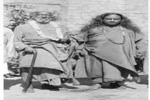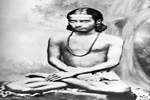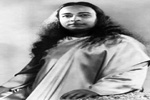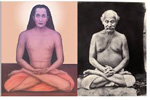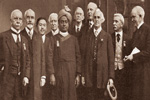
Paramahansa Yogananda
Paramahansa Yogananda is one of the few Yogis who can be credited with the spread of ancient Indian Yogic knowledge overseas. After the pioneering work done by Swami Vivekananda, many other Yogis followed his example. Yogananda devoted his entire life to the spread of Yoga and other sacred ancient Indian sciences in the West.
He went to the US in 1920 at the behest of his Guru Sri Yukteshwara Giri and remained active for the rest of his life in order to spread the message of the Ancient Indian Masters. Even today, the various centers established by him throughout the west are engaged in the fulfillment of his vision. A large number of people are practicing the tenets of KriyaYoga as taught by him.
Parents
Swami Yogananda was born in the Gorakhpur district of Uttar Pradesh on January 5 in the year 1893 as Mukundlal Ghosh. His mother Gyanprabha Ghosh was a spiritually inclined woman. However, his father, Bhagwati Charan Ghosh was initially something of a skeptic in these matters. Once, his assistant, Abinash, petitioned him for leave so that he could visit his Guru in Kashi (Varanasi). The application was rejected by Bhagwati Charan as he felt that one must have the utmost commitment towards one’s job and religious matters were merely distractions that had to be ignored. This saddened the assistant. Within a few days of this incident, the two men met up coincidentally and somehow decided to take a walk together. Bhagwati Charan was trying to explain his casually agnostic point of view to Abinash. However, the latter insisted that the meeting with his Guru, as far as he was concerned, was a matter of life and death.
Even as the two men were discussing this, Lahiri Mahashaya appeared in front of them out of nowhere, all of a sudden and scolded Bhagwati Charan for being too strict with his employee. Yogananda’s father was so profoundly affected by this incident that not only did he grant the application for leave but he himself left for Kashi and received initiation from Lahiri Mahashaya in the art of KriyaYoga. When he took his wife to Lahiri Mahashaya, the great Guru foretold that her son will become a great yogi and will take many people towards god.
Early life
Mukunda exhibited signs at an early age that marked him out as a spiritual prodigy. There was a beautiful portrait of Lahiri Mahashaya in Mukunda’s house. As a child whenever Mukunda tried to concentrate upon it, he felt that Lahiri Mahashaya himself walked out of the frame and meditated sitting next to him. Once, Mukunda was afflicted with cholera. The doctors expressed their inability. His mother asked him to concentrate upon the Guru’s image. As soon as Mukunda began to concentrate upon the portrait, a dazzling light enveloped him wiping out all the symptoms of the disease from the body.
Mukunda began to exhibit extraordinary psychic powers at a very early age. Once, a boil erupted on his sister’s leg. As she was applying an ointment on it, Mukunda snatched the bottle from her, poured the contents onto his arm, and declared that this was a preventive measure for the boil that was soon going to erupt on his own arm. The prediction came true. As a child, his prayers were always granted.
Meeting Yukteshwar Giri
The teenaged Mukunda harbored an intense desire for communion with God. As a teenager, he made two abortive attempts to renounce the world by fleeing to the Himalayas. He did not like applying himself to academic study. However, his father impressed upon him the importance of a good education.
After passing his High-School exam, he started living in an Ashrama in Varanasi. However, the atmosphere of the Ashram was not to his liking and that saddened him. Once, he was walking in the street where he saw a Sadhu standing at some distance, looking directly at him. Without speaking, the Sadhu started walking and Mukunda automatically followed him. As soon as he reached his Ashram, the Sadhu embraced Mukunda as if the latter was his long-lost son. The Sadhu was Swami Yukteshwara Giri, favorite disciple of Lahiri Mahashaya. The Ashram was situated near Kolkata at a place called Srirampur where, in the year 1914, Yogananda took the vows of monk hood. Sixteen years later, he sailed to the US at the behest of his Master.
Yogananda returned from the U.S in the year 1935. In 1936, before he left for the U.S again, he spent the night in a Bombay hotel. His Master had left his body while Yogananda was busy spreading his message in America. He deeply regretted his inability to remain with him in his last moments. Once, as he was meditating in his room, Swami Yukteshwara appeared before him in his astral body. Overwhelmed with heartfelt joy, guru and disciple discussed matters of the spirit. Before leaving, the master promised Yogananda that he would appear before him whenever he appealed sincerely.
In the west
Yogananda worked untiringly for the spread of Indian spiritual knowledge in the west. In 1937, he established an Ashram in California wherein he instituted the Self-Realization Fellowship. Hundreds of branches of this institution are established throughout the world. Through his efforts, Yogananda tried to bridge the gap between the spiritual Orient and the spiritual Occident.
Yogananda was a gifted orator and writer who wrote several books that have been translated in numerous languages. His most famous work is “Autobiography of a Yogi”. It is a first of its kind book wherein an Indian spiritual Guru has revealed some of his practices for the benefit of a primarily Western audience.
Yogananda was a gifted orator and writer who wrote several books that have been translated in numerous languages. His most famous work is “Autobiography of a Yogi”. It is a first of its kind book wherein an Indian spiritual Guru has revealed some of his practices for the benefit of a primarily Western audience.
Yogananda was also a firm believer in the benefits of spiritual healing or Yoga medicine. He was known to cure terminally ill patients with his novel methods that included meditation and prayer. A well-known instance that he also related in his autobiography was when he cured his sister of her unknown and undiagnosed ailment that had reduced her to a bag of bones. His own brother-in-law who was himself a doctor had failed in numerous attempts to cure her.
On the 7th of March, 1952, Yogananda left for his heavenly abode. He had been in perfect health even minutes before his death. He had been invited to a banquet in the honor of the Indian High-Commissioner Mr. Chittranjana Sen. After completing his speech; Yogananda gave up his physical form. His body was kept in a bronze casket for twenty days after his death without the use of any medicine or embalmment. When the casket was opened at the end of the aforesaid period, his physical form was intact. This has been described as a medical marvel.
Yogananda came from a spiritual tradition of great exponents of Kriya-Yoga including the most enigmatic Mahavatara Babaji, Lahiri Mahashaya and Swami Yukteshwara. His greatest contribution was in spreading their teachings throughout the West. In simple words, Kriya Yoga attempts to achieve communion with the supreme soul through specific practices (Kriya). Through constant practice, the individual frees himself from the cycle of Karma. Only serious practitioners are qualified to learn about these ancient traditions. In India, these arts are taught at the Yogada Satsang Society Ashram in Ranchi or at the Yogada Monastery at Dakshineshwara in Kolkata.
